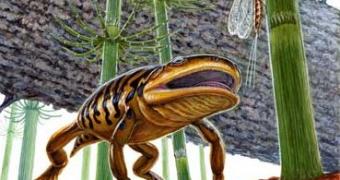The fossil of an animal that lived on Earth some 290 million years ago, having features resembling those of frogs and salamanders alike, has been found during the 1990s in Texas by a paleontologist and colleagues from the Smithsonian Institution. The fossil remained in the collection of the National Museum of Natural History until 2005, when it was rediscovered by at team of researchers from the University of Calgary who identified it as a possible missing link between frogs and salamanders.
The animal, called Gerobatrachus hottoni, seems to have a salamander-like tail and frog-like ears and may be one of the ancestors of modern amphibians, the temnospondyls, from which frogs and salamanders later evolved.
"It had an overall amphibian gestalt. You know, kind of a froggy slamander-y sort of look. But also I recognized some of the archaic features too, and I thought that this would be a critical piece of evidence in trying to work out the origins of modern amphibians. So it's kind of a frogamander, if you will. It pretty convincingly settles the question that the frog and salamander shared origins from the same fossil group", said Jason Anderson, a comparative biologist at the University of Calgary and leader of the study.
"The most astonishing thing to me about this study is that this animal is far more froglike than I would ever have expected from its age. Nothing this nonprimitive has ever been described from this age. It's just amazing", said John Bolt, curator for fossil amphibians and reptiles at The Field Museum in Chicago.
Prior to this discovery, researchers believed that salamanders, frogs and caecilians had a common ancestor, although the new finding showed that caecilians come from a totally different branch of the amphibian evolutionary tree, reopening the old debate arguing that frogs and salamanders share a common ancestor.
"This animal seems to show that frogs and salamanders are more closely related to each other than either are to these elongate caecilians", said Robert Carroll, a paleontologist at McGill University. He pointed out that the features of the animal resemble some of those of older fossils, thus it could just as well be the result of a much earlier division in the amphibian branch which gave rise to frogs and salamanders. "I would say Gerobatrachus was a relic at least in relationship to the question of the ancestry and point of division between frogs and salamanders", Carroll said.
Bolt, on the other hand, called for caution since this is the only Gerobatrachus specimen ever found. "At this point I would say it is by no means certain that this is representative of a common ancestor to frogs and salamanders, although it might be. The fact that something this remarkably like the modern amphibians is present during this period suggests that, really, you could have had an even earlier example of something that was ancestral to modern frogs and salamanders", he said.

 14 DAY TRIAL //
14 DAY TRIAL //